T3: Energy transfers in gravity plumes
Principal investigators: Prof. Torsten Kanzow (MARUM-AWI), Dr. Martin Losch (Afred-Wegener-Institute for Polar and Marine Research)
Objectives
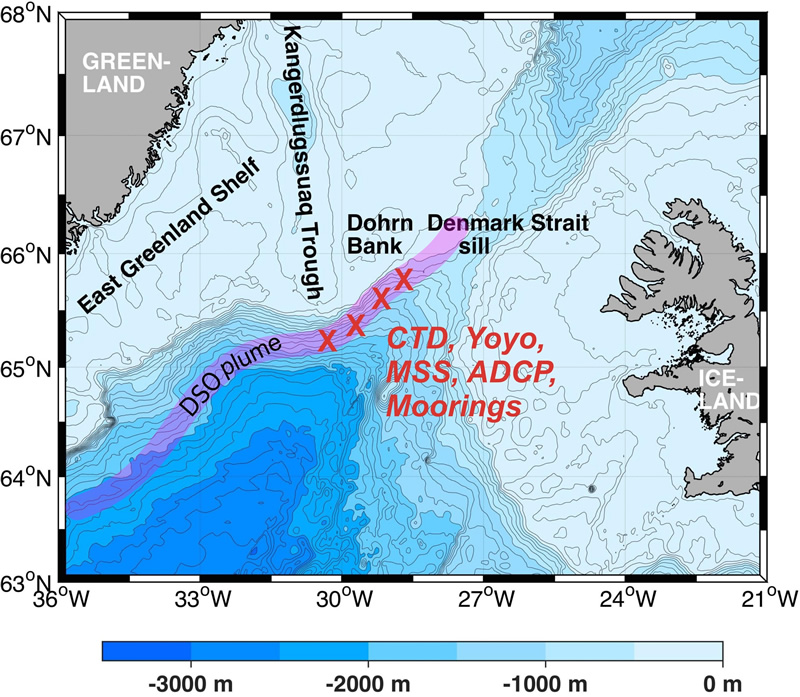
Dense gravity plumes are frequent phenomena in the deep ocean. Often they are associated with rapid water mass modification due to vigorous mixing and entrainment of ambient water. The plume immediately downstream of Denmark Strait is a prototype example for these processes (see Figure below); its current variability is dominated by eddies on timescales of 2–10 days. Using observational and numerical modeling efforts we aim to understand the pathways and processes by which kinetic energy is transferred from the mesoscale eddy field to dissipative turbulent scales within this plume. We will identify the regions of enhanced entrainment of ambient waters into the plume because here the different dynamical regimes exhibit a particularly low degree of scale-separation between the mesoscale, turbulence and dissipative scales.
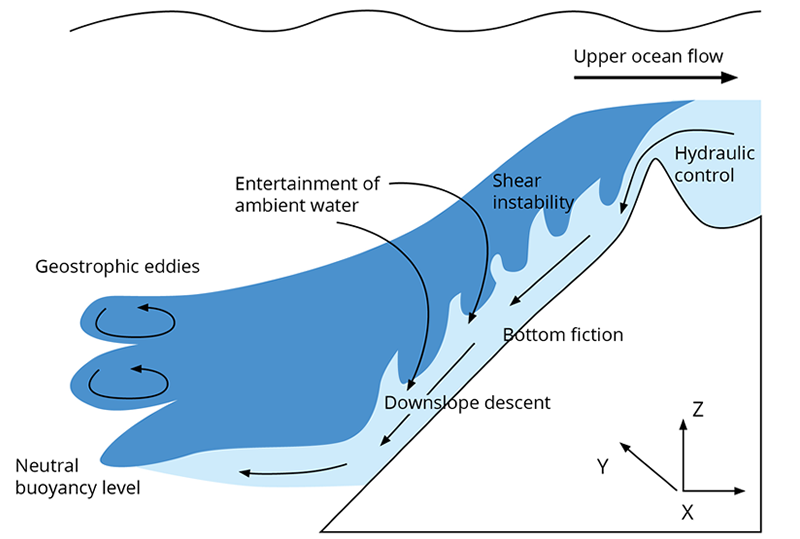
Our main questions are:
- Where are the hot spots of entrainment along the descent of the overflow plume and which physical processes are active at these locations?
- How do both plume-eddy and plume-topography interactions drive the energy transfer across the scales?
- How much of the transfer from potential energy to kinetic energy and mixing can be attributed to gravity wave dissipation and how does this transfer compare to the effects of vertical current shear in overflow eddies?
We address these questions by analyses of new and historical observational data, accompanied by model simulations. Specific model configurations will be established in order to represent the topography and impact of mixing hot spots associated with enhanced turbulence in the Denmark Strait Overflow plume (see general scheme below). These simulations will also serve to study the performance of different parameterizations of eddy dissipation in both high resolution grids and coarse grids used in climate modeling. The observations and model studies will contribute to understanding the energetics of mixing and overflow dynamics. The specific model simulations will be used as a test bed for coarse climate ocean models and hence contribute to the overall goal of the TRR to develop, test and implement new and consistent parameterizations for the effect of unresolved processes.
Phase 1
Main results of phase 1
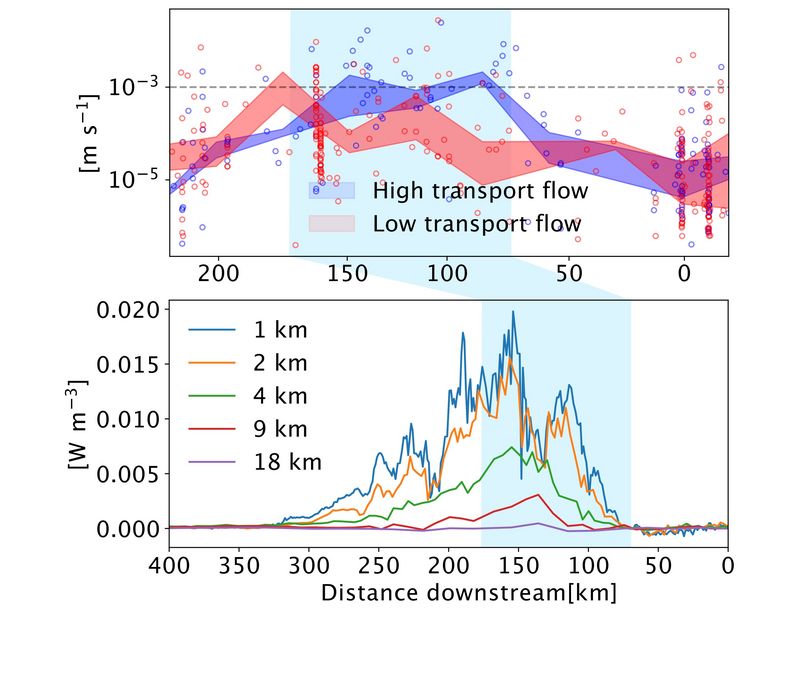
Entrainment rates in the interfacial layer (separating plume and warmer ambient waters) were determined through the analysis of over 30 years of vertical profiles of temperature, salinity and horizontal velocity taken within 200 km downstream of the Denmark Strait sill. Flow type (high vs low transport flow) explains most of the variability in the entrainment rates but the area approximately 75 to 175 km downstream (light blue shading in the upper plot of Fig. 1) was identified as an entrainment hotspot related to high vertical shear in the interfacial layer. These results were corroborated with model simulations of the overflow, which showed that the largest energy transfers occurred in nearly the same downstream region (light blue shading in the lower plot of Fig. 1). Comparing model simulations with grid spacing (horizontal resolution) of 18, 9, 4, 2, and 1 km also implies that there is a convergence of energy transfers with higher resolution, as the computed transfers for the 1 and 2 km simulations display rather similar amplitudes with significantly larger values than those resulting from the 4 km simulation.
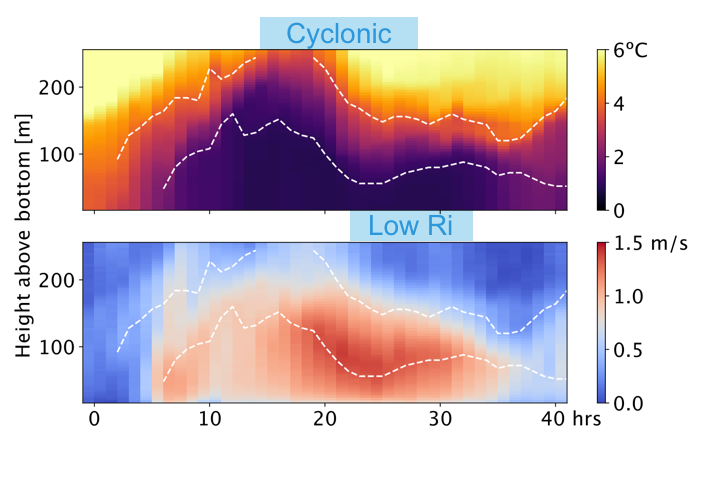
Mooring data collected in the DSO plume 120 km downstream of the Denmark Strait sill revealed that high (>1 m/s) plume velocities coincide with cyclonic eddying activity and low Richardson numbers (<0.25). Low Richardson numbers are a necessary condition for Kelvin-Helmholtz instabilities to occur, suggesting that the interplay of high plume velocities and cyclonic eddy activity provides favorable conditions for a downscale energy transfer toward turbulent mixing (Fig.2).
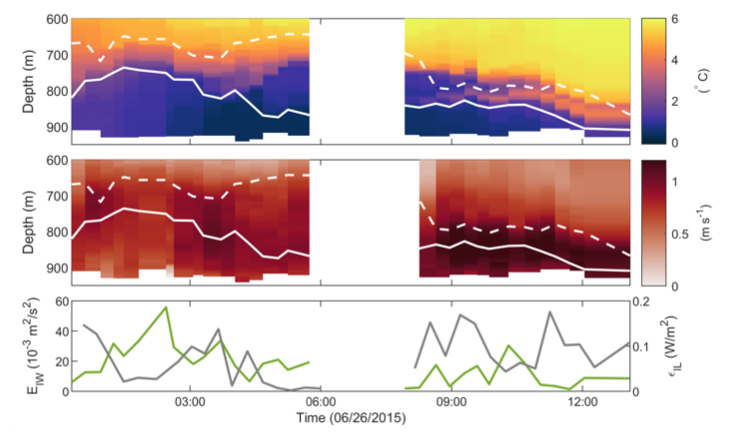
The role of internal waves in the transfer of energy to turbulence in the DSO plume can be observed in consecutive conductivity-temperature-depth (CTD) casts (Fig. 3, top panels), which show the temporal evolution of overflow structure and dynamics. Internal wave energy (EIW) above the overflow (Fig. 3, bottom) was generally enhanced when the plume was thick and propagating slowly (Fig. 3, middle panels), and decreased when the plume thinned and flowed faster. Conversely, turbulent kinetic energy dissipation rates in the interfacial layer (IL) were highest when the overflow was thinner and velocities were high, most likely caused by shear-driven turbulent mixing. This suggests that when the overflow was thicker and less vertically sheared, relatively more large-scale mean kinetic energy was converted to internal wave energy than to shear driven dissipation. The source of the internal waves, and their role in transferring energy away from the overflow, cannot be determined by observations alone. Thus, modelling efforts will be used in the future to examine the generation and impact of internal waves on the overall energy of the DSO.
Invited Guests
Reports
Research Stay in Hokkaido by Nicolas Dettling (Nov 23)

My name is Nicolas Dettling, I am a PhD student in subproject T3 „Energy Transfers in Gravity Currents“. So far I have worked on applying and improving eddy parameterizations in the presence of gravity currents, such as the ones exporting dense water from the Antarctic continental shelves. Now, it is time to apply what we have found in idealised models to regional models of the Antarctic marginal seas.
For this purpose, I visited Prof. Yoshihiro Nakayama and his research group at the Institute for Low Temperature Science at Hokkaido University, Japan in November. Over the last years, Prof. Nakayama and his group have set up a number of regional ocean model simulations targeting key questions concerning the dynamics of the ocean around the Antarctic continental shelf and slope. Over the course of three weeks, I was introduced to a model of the Cape Darnley region, where dense water flows down the continental slope into the abyssal ocean, providing a nice test case for my previous parameterization work. I learned how to set up, run and interpret the model at different resolutions and we discussed the steps towards applying an eddy parameterization in the model. I am very grateful for the support and the fruitful discussions during my time at the institute.
The Hokkaido University campus is centred around a park and every morning I would walk along the Ginkgo Avenue enjoying the autumn colours on my way to work. Fortunately, there was also time to explore the City of Sapporo and the beautiful nature of Hokkaido, where the first snow of the season had already arrived. Luckily, the next Hokkaido Soup Curry or a bunch of Gyozas (fried dumplings) were never far away to recover after working or travelling.
I genuinely enjoyed to work in Japan and to engage in this cultural exchange. I would like to thank Prof. Nakayama and his group for their hospitality and I am very much looking forward to working together again in the future. Finally I want to thank the TRR 181 for funding the research visit.
To resolve or not to resolve?
I’m investigating effects of grid resolution on the modification of overflow and ocean energetics.
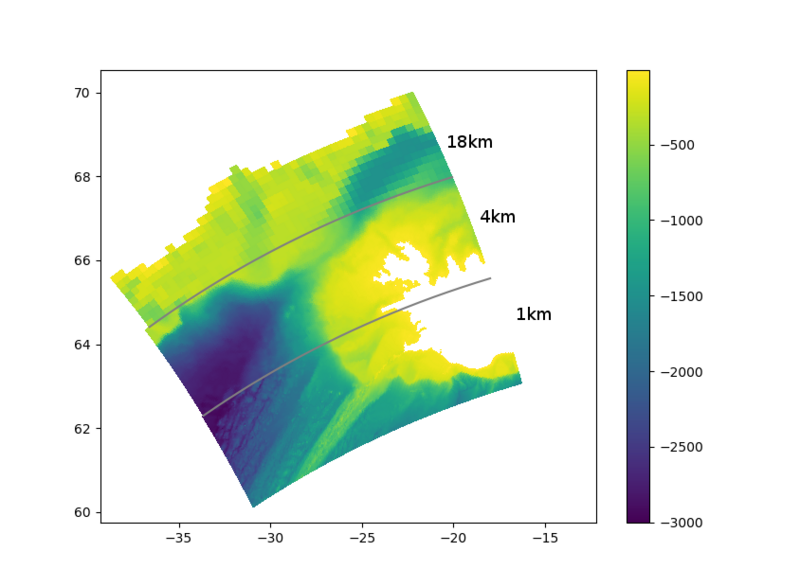
I am Deniz and I work on the T3 ‘Energy transfers in gravity plumes’ project as a PhD candidate at AWI. In particularly we are interested in the Denmark Strait Overflow (DSO) which is between Greenland and Iceland. This location is special because the DSO carries most of the dense and cold Arctic water entering the North Atlantic. Thus contributing to the deep southward flowing part of the Atlantic meridional overturning circulation.
As soon as the dense water on the sill starts descending, it undergoes a significant amount of mixing and entrainment of ambient water. By 200km downstream of the sill, volume and tracer properties of the overflow water are substantially modified due to combination of different processes. In our subproject we try to understand the interactions of all these different processes at different scales using observational and numerical modeling analysis.
It’s difficult to properly represent overflows in a global ocean model with the coarse resolution climate models generally have. For my part in this subproject, I use a general circulation model (MITgcm) in a regional setup with a 1year of simulation period. I’m investigating effects of grid resolution on the modification of overflow and ocean energetics. For this purpose I use 6 different horizontal resolutions ranging from eddy resolving (1km) to coarse resolution (36km). At the moment, I am analyzing the results from higher resolution simulations. Soon coarser resolutions will come into the picture and analysis of eddy parameterization schemes along with them. My research will contribute to a better understanding of consequences of lacking smaller scale processes and better representation of them in coarser models.
Publications
Štulic, L., Timmermann, R., Paul, S., Zentek, R., Heinemann, G. & Kanzow, T. (2023). Southern Weddell Sea surface freshwater flux modulated by icescape and atmospheric forcing. Ocean Sci. 19, 1791–1808, doi: https://doi.org/10.5194/os-19-1791-2023.
Olbers, D., Pollmann, F., Patel, A. & Eden, C. (2023). A model of energy and spectral shape for the internal gravity wave field in the deep-sea – The parametric IDEMIX model. J. Phys.Oceanogr. 53(5), doi: https://doi.org/10.1175/JPO-D-22-0147.1.
Llanillo, P. J., Kanzow, T., Janout, M. A., & Rohardt, G. (2023). The deep-water plume in the northwestern Weddell Sea, Antarctica: Mean state, seasonal cycle and interannual variability influenced by climate modes. J. Geophys. Res. 128(2), e2022JC019375, doi: https://doi.org/10.1029/2022JC019375.
Moritz, M., Jochumsen, K., North, R. P., Quadfasel, D. & Valdimarsson, H. (2019). Mesoscale Eddies observed at the Denmark Strait sill. J. Geophys. Res.-Oceans, https://doi.org/10.1029/2019JC015273.
Liang, X., and Losch, M. (2018). On the effects of increased vertical mixing on the Arctic Ocean and sea ice. J. Geophys. Res.-Oceans., 123, 9266–9282, doi: doi.org/10.1029/2018JC014303.
North, R. P., Jochumsen, K. & Moritz, M. (2018). Entrainment and Energy Transfer Variability Along the Descending Path of the Denmark Strait Overflow Plume. J. Geophys. Res.-Oceans, 123(4), 2795-2807, doi: https://doi.org/10.1002/2018JC013821.
